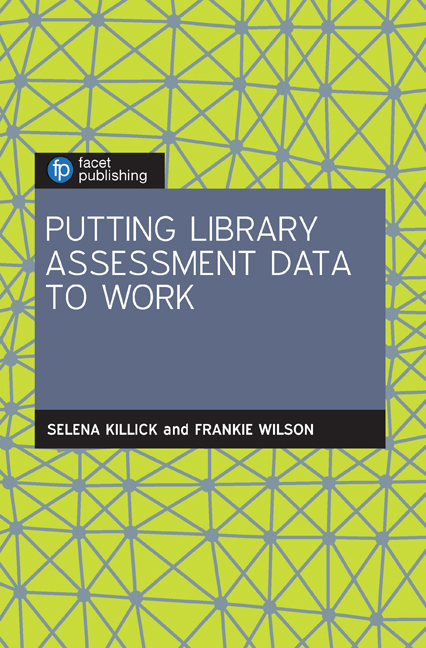Book contents
- Frontmatter
- Dedication
- Contents
- List of figures and tables
- List of case studies
- Authors and contributors
- Acknowledgements
- 1 Introduction to Library Assessment
- 2 Institutional Measures of Student Satisfaction
- 3 Standardised Library Surveys
- 4 In-House Library Surveys
- 5 Library Statistics
- 6 Qualitative Feedback
- 7 Emerging Techniques
- 8 More than Measuring: using Assessment Holistically
- 9 Conclusions
- Index
9 - Conclusions
Published online by Cambridge University Press: 02 October 2019
- Frontmatter
- Dedication
- Contents
- List of figures and tables
- List of case studies
- Authors and contributors
- Acknowledgements
- 1 Introduction to Library Assessment
- 2 Institutional Measures of Student Satisfaction
- 3 Standardised Library Surveys
- 4 In-House Library Surveys
- 5 Library Statistics
- 6 Qualitative Feedback
- 7 Emerging Techniques
- 8 More than Measuring: using Assessment Holistically
- 9 Conclusions
- Index
Summary
We hope this book has given you the basics you need to apply a variety of assessment methodologies in your library. You may wish to use institutional measures of customer satisfaction to advocate for the library with senior institutional administrators – as evidence of the impact of library provision on the customer experience and/or to argue for the necessary resources to make improvements.
Alternatively you may want to use the results of a standardised library survey to benchmark against others to identify your library's strengths and opportunities for improvement. Or maybe responses to an in-house library survey could help you understand your customers’ needs and what actions your library staff need to take to improve their experience.
Maybe you have a plethora of library data sets, such as circulation statistics, that you want to use to inform decision making and service planning.
Perhaps it is qualitative feedback that you have collected and now wish to harness to gain understanding and insight into your customers’ interactions with your library, and thereby make improvements. Or you now realise that data is an encompassing term for both quantitative and qualitative information, and they must be used in combination for your library to have a complete understanding of the matter.
Or maybe you have made full use of all the data you have and there is still something missing, so you are inspired to apply an emerging technique in library assessment at your library.
We hope the case studies have inspired you and shown how the theory works in the real world. We hope that after reading this book you will bring together a variety of sources of data and feedback to give your library a deeper understanding of users’ needs and the impact of service changes, thereby continually improving customers’ experience. We hope that you will use the same data, carefully communicated, to tell the story of your library service in a meaningful way and so secure future funding.
Culture shift
When case study authors or presenters at library assessment conferences provide the context for their library, the default of even the enthusiastic few at the cutting edge of this area is to provide statistics about the size of their collections and the population they serve.
- Type
- Chapter
- Information
- Putting Library Assessment Data to Work , pp. 163 - 166Publisher: FacetPrint publication year: 2019

